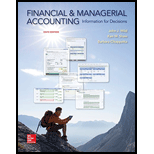
1.
To explain: Transaction of the
1.
Explanation of Solution
a.
Sale of common stock of $1, each issued at $40 and the number of shares is 3,000.
b.
Common stock of $1 each issued at $40 to the promoters of the company for their efforts to set up the company. Total number of shares issue is 1,000.
c.
Assets and liabilities acquired through common stock issue of $800. Common stock has a par value $1 and issued at $50.
d.
Sale of common stock of $1, each issued at $50 and the number of shares is 1,200.
2.
To compute: Number of common shares outstanding at the year’s end.
2.
Explanation of Solution
Given,
Shares issue in transaction ‘a.’ is 3,000.
Shares issue in transaction ‘b.’ is 1,000.
Shares issue in transaction ‘c.’ is 800.
Shares issue in transaction ‘d.’ is 1,200.
Formula for number of shares outstanding is:
Substitute 3,000 for shares issue in transaction a, 1,000 for shares issue in transaction b, 800 for shares issue in transaction c and 1,200 for shares issue in transaction d in the above formula,
Hence, numbers of shares outstanding at the yearend are 6,000.
3.
To compute: Minimum legal capital.
3.
Explanation of Solution
The number of outstanding share is 6,000 (calculated in part 2.).
Formula for minimum legal capital is:
Substitute 6,000 for number of outstanding share, and $1 for par value per share in the above formula,
Hence, minimum legal capital is $6,000.
4.
To compute: Total paid in capital at the end of the year.
4.
Explanation of Solution
Given,
Paid in capital in transaction a is $117,000.
Paid in capital in transaction b is $39,000.
Paid in capital in transaction c is $39,200.
Paid in capital in transaction d is $58,800.
Formula for paid in capital is:
Substitute $6,000 for minimum legal capital, $120,000 for paid in capital in transaction a, $40,000 for paid in capital in transaction b, $40,000 for paid in capital in transaction c and $60,000 for paid in capital in transaction d in the above formula,
Hence, total paid in capital at the yearend is $260,000.
5.
To compute: Book value of share.
5.
Explanation of Solution
Number of common shares is 6,000.
Formula for book value per share is:
Substitute, $283,200 for stockholder’s equity, $0 for preferred stock and 6,000 for number of common shares in the above formula,
Hence, the book value per share is $47.2.
Want to see more full solutions like this?
Chapter 11 Solutions
Financial and Managerial Accounting: Information for Decisions

 AccountingAccountingISBN:9781337272094Author:WARREN, Carl S., Reeve, James M., Duchac, Jonathan E.Publisher:Cengage Learning,
AccountingAccountingISBN:9781337272094Author:WARREN, Carl S., Reeve, James M., Duchac, Jonathan E.Publisher:Cengage Learning, Accounting Information SystemsAccountingISBN:9781337619202Author:Hall, James A.Publisher:Cengage Learning,
Accounting Information SystemsAccountingISBN:9781337619202Author:Hall, James A.Publisher:Cengage Learning, Horngren's Cost Accounting: A Managerial Emphasis...AccountingISBN:9780134475585Author:Srikant M. Datar, Madhav V. RajanPublisher:PEARSON
Horngren's Cost Accounting: A Managerial Emphasis...AccountingISBN:9780134475585Author:Srikant M. Datar, Madhav V. RajanPublisher:PEARSON Intermediate AccountingAccountingISBN:9781259722660Author:J. David Spiceland, Mark W. Nelson, Wayne M ThomasPublisher:McGraw-Hill Education
Intermediate AccountingAccountingISBN:9781259722660Author:J. David Spiceland, Mark W. Nelson, Wayne M ThomasPublisher:McGraw-Hill Education Financial and Managerial AccountingAccountingISBN:9781259726705Author:John J Wild, Ken W. Shaw, Barbara Chiappetta Fundamental Accounting PrinciplesPublisher:McGraw-Hill Education
Financial and Managerial AccountingAccountingISBN:9781259726705Author:John J Wild, Ken W. Shaw, Barbara Chiappetta Fundamental Accounting PrinciplesPublisher:McGraw-Hill Education





